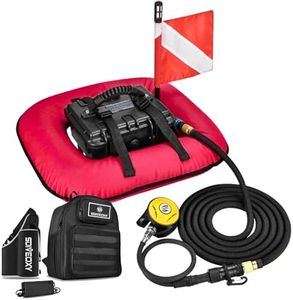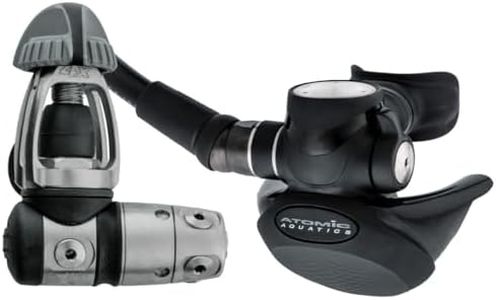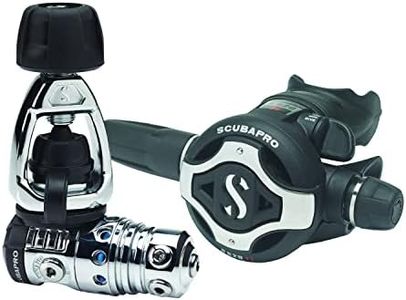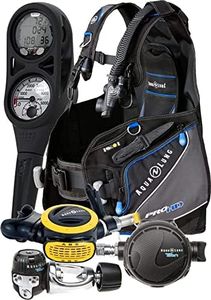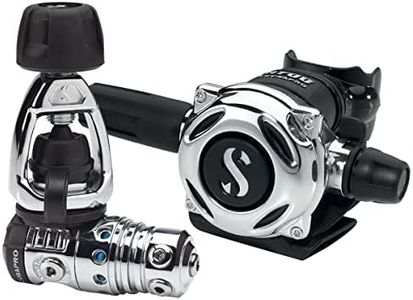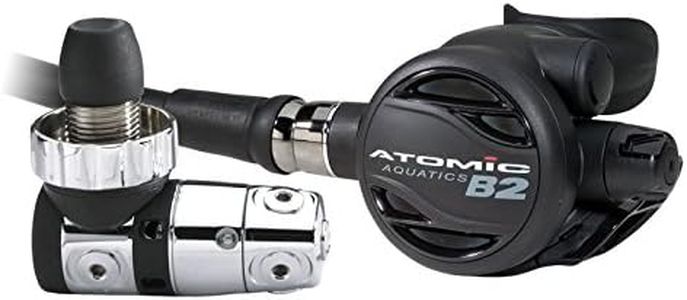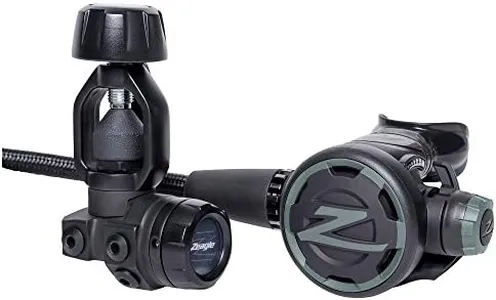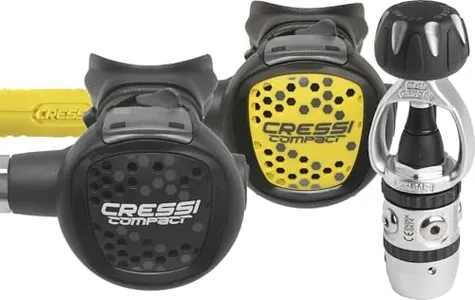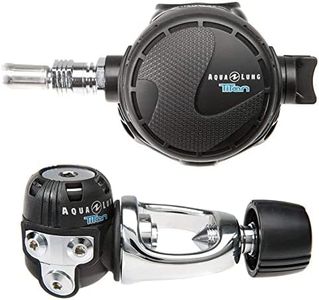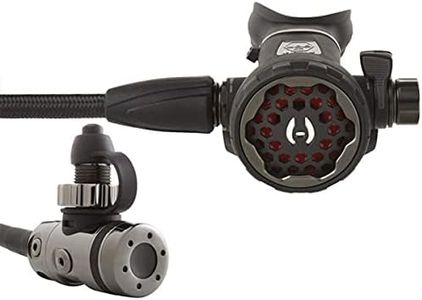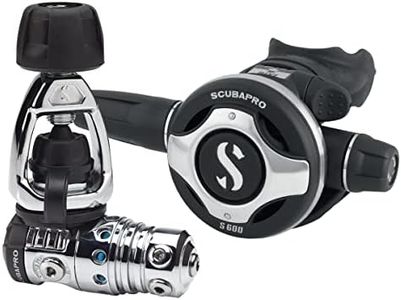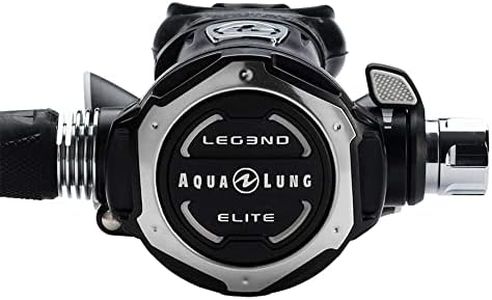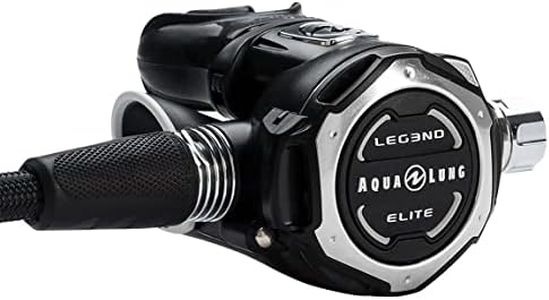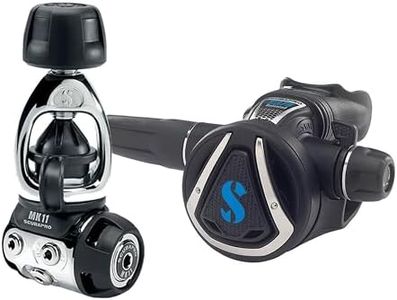10 Best Scuba Diving Regulators 2025 in the United States
Our technology thoroughly searches through the online shopping world, reviewing hundreds of sites. We then process and analyze this information, updating in real-time to bring you the latest top-rated products. This way, you always get the best and most current options available.

Our Top Picks
Winner
Atomic Aquatics TFX Scuba Diving Regulator | Unique Front Exhaust Design | Provides Effortless Breathing in All Diving Positions| Durable Titanium Components | Yoke
Most important from
2 reviews
The Atomic Aquatics TFX Scuba Diving Regulator stands out with its unique front exhaust design, which makes breathing easier and keeps you dry in all diving positions, especially when looking up. This is a significant advantage over traditional rear exhaust regulators.
The use of durable titanium components in both the first and second stages ensures longevity and reliability, making this regulator a solid investment for serious divers. The first stage's Yoke design is user-friendly, allowing quick and easy attachment or removal from the tank with just one turn. It is also nitrox ready and freeze-protected, adding to its versatility and safety in various diving environments.
The factory-sealed feature prevents outside contamination, which is crucial for maintaining performance and hygiene. The second stage offers a variable lift cam and an adjustable venturi nozzle gear, providing more control and customization of breathing resistance. Additionally, the comfort swivel hose enhances flexibility and comfort underwater. However, the weight and size of the product might be on the heavier side, which could be a drawback for divers who prefer more lightweight gear. With an item weight of 3 pounds and dimensions of 15 x 12.25 x 5 inches, it is relatively bulky compared to some other models on the market. Despite these minor downsides, the regulator’s performance and quality materials make it a strong contender for divers seeking a reliable and high-performing regulator.
Most important from
2 reviews
SCUBAPRO MK25 EVO/S620 Ti Diving Regulator System for Scuba Diving, INT
Most important from
33 reviews
The SCUBAPRO MK25 EVO/S620 Ti Diving Regulator System is designed for divers seeking a reliable and high-performance regulator. One of its standout features is the air-balanced flow-through piston housed in a chrome-plated brass body, which ensures consistent airflow regardless of depth or tank pressure. This makes it a suitable choice for divers who often venture into varying underwater environments. Additionally, the system's Extended Thermal Insulating System enhances cold-water performance, making it a good option for cold-water diving.
The regulator is lightweight and compact, featuring a titanium barrel that is both rugged and anti-corrosive, adding to its durability and ease of handling. It comes with multiple high-flow ports and two opposing high-pressure ports, offering flexible hose configurations and convenient positioning of the first stage. The second stage is smaller and lighter than its predecessor while maintaining high inhalation sensitivity, which is great for seamless air delivery. Adjustable intermediate pressure settings allow for quick and easy fine-tuning by technicians.
However, the product's weight limit of 3 pounds and lack of a hand orientation option might be limiting for some users. It's also worth noting that the MK25 EVO/S620 Ti is more expensive, which might be a consideration for budget-conscious buyers. Divers who prioritize performance, durability, and flexibility will find this regulator system a worthwhile investment.
Most important from
33 reviews
Aqua Lung Pro HD BCD i300 Dive Computer Titan / ABS Regulator Set,Medium
The Aqua Lung Pro HD BCD i300 Dive Computer Titan / ABS Regulator Set is a solid choice for scuba divers seeking reliable performance and ease of use. The Titan regulator's balanced-diaphragm mechanism ensures consistent breathing efforts and protects internal components from environmental factors. This makes it suitable for various diving conditions.
The set includes the i300C Dive Computer, which offers Air and Nitrox modes, and Bluetooth connectivity for effortless operation and data tracking, enhancing the diving experience for both beginners and seasoned divers. The Pro HD BCD features a wrap-around jacket design with integrated weights, ensuring comfort and durability against salt and chlorine exposure.
The ABS Octopus regulator adds to the set's safety and performance with its low-profile design and reliable breathing efficiency. However, some users might find the weight of 13.6 pounds substantial, potentially affecting portability. Also, the knife, though mentioned, is sold separately, which might be an inconvenience for some buyers. This set is suitable for both recreational and more experienced divers who prioritize performance, durability, and advanced features in their diving equipment.
Buying Guide for the Best Scuba Diving Regulators
Choosing the right scuba diving regulator is crucial for ensuring a safe and enjoyable diving experience. A regulator is the device that allows you to breathe underwater by reducing the high-pressure air from your tank to a breathable pressure. When selecting a regulator, it's important to consider various specifications to find the best fit for your diving needs. Here are the key specs to look at and how to navigate them.FAQ
Most Popular Categories Right Now
